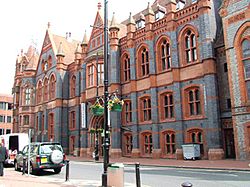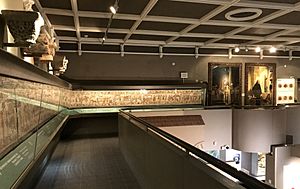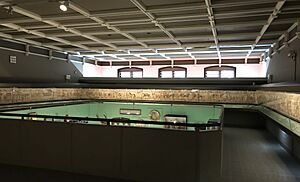Reading Museum facts for kids

The entrance to the Reading Museum within Reading Town Hall
|
|
| Lua error in Module:Location_map at line 420: attempt to index field 'wikibase' (a nil value). | |
| Established | 1883 |
|---|---|
| Location | Reading, Berkshire, UK |
| Type | Local museum |
| Public transit access | Reading railway station |
The Reading Museum is a cool place to learn about the history of Reading, a town in England. It's inside the Reading Town Hall building. The museum shows off many interesting things, like old objects from Calleva Atrebatum (a Roman town), a copy of the famous Bayeux Tapestry, and items from Reading Abbey. It also has a great art collection!
Contents
History of the Reading Museum
The Reading Town Hall building, where the museum is, was built over many years. A new part of the building, which included a library and the museum, opened in 1883. The museum started with a large collection of items from a person named Horatio Bland. Later, in 1897, three art galleries were added.
In 1975, the town offices moved out of the Town Hall. The Reading Central Library also moved in 1985. This left only the museum and a concert hall in the building. After some discussions, plans to knock down the Town Hall were stopped. Instead, the building started to be fixed up in 1986. The museum closed for a big update in 1989. It then reopened in different stages from 1993 to 2000.
What to See: Main Galleries
The Story of Reading Gallery
This gallery tells the story of Reading from its very beginning. Reading started as an Anglo-Saxon settlement around the 6th century. The gallery uses videos, interactive displays, and real objects from different time periods. It especially focuses on the history of Reading Abbey.
The Silchester Gallery
This gallery is full of amazing finds from the old Roman town of Calleva Atrebatum, also known as Silchester Roman Town. You can see many archaeological objects found there. There are also models and information about what life was like in a Roman town.
One special item is the bronze Silchester eagle. This eagle became famous in the children's book The Eagle of the Ninth by Rosemary Sutcliff. The Roman town was dug up in the 1860s. Many items like jewelry, glass, pottery, sculptures, and coins were found. You can see many of these items in the gallery. Other important items include the Silchester Horse and a damaged head of Seraphis. There's also a model of the Roman town.
The Atrium
The Atrium is a space where you can sit and relax. It has a Roman mosaic pavement from the Silchester site. People think a 4th-century Christian church might have been there. On the walls, you can see two large mosaics also from Silchester. Next to these mosaics are beautiful ceramic pieces made by Alan Caiger-Smith.
The Bayeux Gallery
The Reading Museum has a very accurate copy of the famous Bayeux Tapestry. This copy was made by 35 women from the Leek Embroidery Society in 1885. It's the only full-size woven copy of the original tapestry known to exist.
The tapestry is 70 meters long! It shows the events of the Norman Conquest of England in 1066. This includes how the conflict started, the preparations for war, and the big Norman victory at the Battle of Hastings. Information boards help you understand the story. They translate the old Latin words and explain the history of the conquest. The very last part of the original tapestry, which showed William's crowning, was lost before this copy was made. This history is important to Reading because King William's youngest son, Henry I, founded Reading Abbey in 1121. He was also buried there in 1136.
The gallery also has information about the history of Saxon people and Viking raids in the local area.
The Green Space
This gallery teaches you about the geology and natural history of the Reading area. It has many different specimens on display. You can learn about the area's history from 400 million years ago up to today. It shows what was in the area before people lived there. It also explains how Reading's landscape and environment have changed over time, especially since the Stone Age.
The gallery also shows the animals and plants that live in the Reading area today. Some cool things to see include a complete Iron Age dog skeleton. This skeleton was found at Blewburton hillfort. Another highlight is a royal red deer stag. This stag was given to the museum by George V from the royal herd at Windsor Great Park.
Huntley & Palmers Gallery
This gallery tells the story of biscuit-making in Reading. Making biscuits used to be a very important industry for the town. It focuses on the Huntley and Palmers company, which was famous worldwide for its biscuits. The display shows how Huntley & Palmers became pioneers in making biscuits for everyone. It also explains why Reading became known as the 'Biscuit Town'.
The gallery shows what factory life was like for the thousands of people who worked at Huntley & Palmers. You can hear recordings, see old photos, and watch historical films. One film is even the earliest surviving film of a British factory! Highlights include about 300 decorative biscuit tins and old advertisements. There's also an African thumb piano made from a Huntley & Palmers biscuit tin. You can even see a biscuit that was taken on Captain Scott's last trip to Antarctica!
The Windows Gallery
This gallery is called The Windows Gallery because it's like a 'window' into the museum's large collection of sculptures and decorative art. It has pieces from the 12th century, like Romanesque stones from Reading Abbey. It also has modern art by famous artists like Rodin and Epstein.
This part of the museum used to be the Reading School of Art. It was designed to have lots of natural light from the windows. Important items in this collection include 12th-century Romanesque stone carvings from Reading Abbey. You can also see sculptures by Rodin, Epstein, and Gibbings, along with Delftware plates and other ceramics.
The Sir John Madejski Art Gallery
This gallery is a recreation of the museum's original art gallery from the Victorian era. It hosts changing exhibitions of different artworks. It is named after John Madejski, who was the chairman of Reading F.C..
The Exhibition Gallery
This space is used for special, changing exhibitions. These exhibitions can feature items from the museum's own collection or from other places. For example, in late 2004, this gallery had an exhibition about the history of the Reading Festival.
Visiting the Museum
It's free to visit the Reading Museum! As of early 2020, the museum is open from Tuesday to Friday, 10:00 AM to 4:00 PM. On Saturdays, it's open from 10:00 AM to 5:00 PM. The museum is closed on Mondays and Sundays, except for some holidays.
Supporting the Museum
The Reading Foundation for Art was started in 1974. Its goal was to build an art collection to make life better for local people and improve the culture of Reading. It now has over 150 artworks that are on permanent loan to Reading Museum. This foundation is a registered charity.





